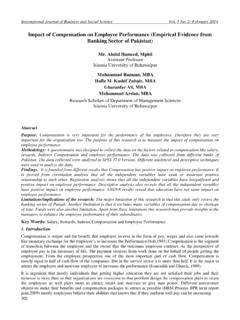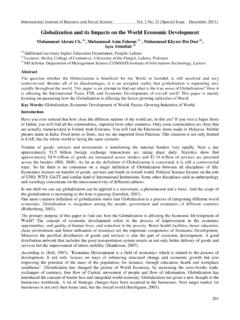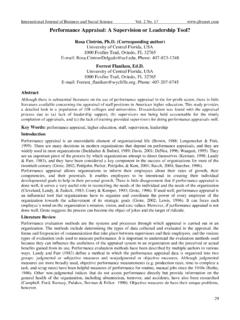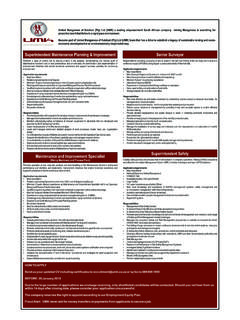Transcription of International Journal of Business and Social …
1 International Journal of Business and Social Science Vol. 2 No. 13 [Special Issue - July 2011]. Defensive and Offensive strategies for Market Success Dr. Peter Yannopoulos Associate Professor Brock University, St. Catharines Ontario, Canada, L2S 3A1. E-mail: Tel: (905) 688-5550 ext. 3909. Abstract In industries in which there is strategic interaction among competing firms, companies are continuously involved in defensive and offensive strategies . In this paper we discuss several defensive and offensive strategies that managers can you for market success. Defensive strategies are divided into pre-entry and post-entry stretegies. Marketing managers should attempt to discourage would be entrants before entry has occurred. They can achieve this goal by engaging in pre-entry startegies. After entry is occurred it is more difficult to persuade new entrants to exit the industry. For this reason, marketing managers should use different defensive strategies for defending their positions in pre-entry and post-entry situations.
2 Key words: Defensive strategies , offensive strategies , pre-entry strategies , post-entry strategies 1. Introduction Competition forces companies to constantly engage in offensive and defensive marketing strategies . Rivalry occurs because one or more competitors either feels the pressure or sees an opportunity to enter an industry or to improve its position within an industry. In most cases, competitive moves by one firm have noticeable effects on its competitors and, thus, may invite retaliation or efforts to counter the move (Porter 1980). Companies respond to competitor challenges by counterattacking with increasing advertising expenditures, cutting prices, increasing innovation, and introducing new products, or even accommodating the entrant by doing nothing or decreasing the level of marketing effort (Karakaya and Yannopoulos, 2011; Scherer, 1980). Firms grow by taking market share from rivals or creating new markets. Incumbents need to be prepared for attacks by existing firms seeking to expand their Business and new entrants.
3 The incumbents' objective is to defend their market share and strengthen their position by making it harder for companies to enter or for existing firms to challenge them. Incumbent firms may also attack in an attempt to enter a new market, reposition themselves, or improve their market position. Markets are dynamic arenas where firms try to expand into their industries or reposition themselves in other segments within the industry. As firms attempt to improve their position, they engage in competitive battles and adopt offensive strategies . Successful use of offensive strategies can help a firm improve its competitive position, gain market share, and increase profits. In this paper we discuss both defensive and offensive marketing strategies . We, first, discuss the pre-entry and post-entry defensive marketing strategies , and, then, a number of offensive marketing strategies . Defensive strategies Because of ongoing rivalry, established firms need to engage in defensive strategies to fend off the various challengers.
4 The primary purpose of defensive strategy is to make a possible attack unattractive and discourage potential challengers from attacking another firm. Incumbents try to shape the challenger's expectations about the industry's profitability and convince them that the return on their investment will be so low that it does not warrant making an investment in that industry. Defensive strategies work better when they take place before the challenger makes an investment in the industry, or if they enter the industry before exit barriers are raised, making it difficult for the challenger to leave the industry. For this reason, an incumbent needs to take timely action to discourage a challenger from making any substantial commitment, because once the commitment is made, it is more difficult to dissuade the challenger from following through with the attack especially if exit barriers are high. If an attack has already begun, a defending firm may attempt to lower its intensity and potential for harm, by directing the attack to areas where the firm is less vulnerable, or in areas which are less desirable to the attacker (Porter, 1985).
5 Or they should initiate actions designed to make the entrant's life difficult after entry has occurred. This may convince the entrant that its calculations were too optimistic and its early experience in the industry is so negative that it does not warrant continuing the entry effort. 1. The Special Issue on Business and Management Centre for Promoting Ideas, USA Over the years, marketing managers and Business strategists have developed a number of defensive marketing strategies to defend their position and maintain their sales and profitability. There are two types of defensive marketing strategies . Pre-entry strategies are actions taken by incumbents before they are attacked by challengers. Defensive marketing strategies may also take the form of post-entry actions that are initiated after the challenger has entered the market (see Table 1). Pre-Entry Defensive strategies Pre-entry defensive strategies are actions taken by firms intended to persuade potential entrants to believe that market entry would be difficult or unprofitable.
6 Such actions include signaling, fortify and defend, covering all bases, continuous improvement, and capacity expansion. Table 1: Defensive strategies Defensive strategies Pre-entry strategies Post-entry strategies Signaling Defend position before entrant Fortify and defend becomes established Cover all bases Introduce fighting brands Continuous improvement Engage in cross-parry Capacity expansion Signaling Companies often use signaling to announce their intention to take an action. Announcements can be made through interviews with the press, press releases, speeches, trade journals, newspapers, and other means. Such announcements may serve different objectives which are not necessarily mutually exclusive. They could signal commitment to the industry and therefore try to preempt or deter competitors. A defending firm can effectively keep potential entrants out of the industry by using the threat of retaliation. The higher the perceived probability of retaliation and its degree of severity, the lower the probability of attack by a challenger.
7 Firms enhance their reputation for rigorous retaliation by the way they responded to past attacks, which signals their commitment to defend their market share. Other times, companies announce their intention to undersell their competitors. Future Shop, a large chain of consumer electronics in Canada, has publicly stated that it will not be undercut by competitors and that it will meet their prices. Announcements may be used to issue a threat that action will be taken if a competitor makes a certain move. For example, firms can announce that they will match a rival's prices, rebates, credit, or any other terms offered. Fortify and Defend This strategy attempts to build barriers to entry for competitors. The purpose of defensive marketing strategies is to lower the inducement to attack. Firms frequently enter an industry because existing firms earn high profits. The higher the profits earned by incumbent firms, the higher the motivation to enter. Thus, the inducement to attack can be lowered by reducing the profit expectations of the entrant.
8 This can be achieved by raising barriers to entry for new competitors. Erecting barriers usually hinders entry by new competitors because they will have to incur costs not born by existing competitors. The most common barriers to entry include economies of scale, product differentiation, capital requirements, switching costs, experience curve cost reductions, proprietary technology or patents, access to raw materials and other inputs, access to distribution channels, and location (Yannopoulos, 2007). Industries in which there are significant barriers to entry include the automobile, aerospace, and ship- building industries. Because of high barriers, entry is notoriously difficult in these industries. Cover All Bases Covering all bases, also called product proliferation, entails introducing new products to ensure a full product line or to fill gaps in the market. Covering all bases may involve introducing multiple versions of a product in terms of models or product types. Many firms carry full product lines to block access to the industry by new entrants.
9 For example, the leading ready-to-eat cereal companies compete with a full-line, making it very difficult for other companies to enter and threaten their position. 2. International Journal of Business and Social Science Vol. 2 No. 13 [Special Issue - July 2011]. This strategy is also used by chain stores when they rush to expand rapidly and keep competitors out of the market. A firm that floods the market avoids being outflanked by competitors. It is also a way to tie up distribution channels and shelf space. For example, Procter & Gamble, a master practitioner of this strategy, dominates retail shelf space with products such as Ivory Soap, Crest, Tide, Pantene Pro-V and many others. A. firm that is trying to cover all bases may face one or more of the following difficulties. First, some firms, especially the small ones, may not have the resources to offer a full product line. Second, product proliferation may cause a firm to spread its resources too thinly, violating the principle of concentration of forces at the decisive point.
10 Covering too many markets and overextending itself, leaves a firm vulnerable to competitor attacks, as it makes for an easy target. Third, this strategy cannot fully protect a company from attacks by other competitors who wish to enter the industry. Even if a firm was able to cover the major segments, it is impossible to cover every possible niche in the market. This allows small companies to enter the market and occupy these niches. These niches, although small and unattractive at the time, often explode into large segments posing a threat to established firms. A special case of the cover-all-bases strategy is the introduction of a blocking brand. Blocking brands are used by incumbent firms to block access to the market by potential entrants. The firm introduces a brand designed to fill a niche in the market that could be used as a point of entry by a competitor. The intent of introducing a blocking brand often is to protect an existing profitable brand by precluding competitors from entering the market and stealing market share by undercutting the price of the existing product.
















